A Paipo Interview with Tony Dawes
October 25, 2010 - Manly, Australia
Telephone interview by Bob Green
"Bellyboards were chestboards when we rode
them." Tony was one of a group of guys from the Manly Surf Club who
rode twin-finned balsa boards from the late-1950s. Tony was also an
accomplished surfboat rower.
1. How old were you when you first started riding a chestboard? Where was this?
It was Manly, I suppose I was 23, or something like that.
2.Were there many others riding chestboards at this time?
Not a great deal outside a group of us, of about eight in the Manly
Surf Club, who used to go out riding them at different areas when the
waves were on. 3. What was your first board like? Who made it?
As far as I know the first one was made by Bill Clymer. It was balsa,
with a rim around the front that you held onto and four inch fins on
the back.
|
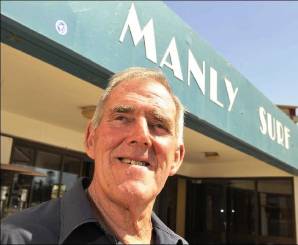
Tony Dawes outside the Manly Surf Club.
Photo courtesy of Martin Lange, Manly Advertiser. |
|
So that was a Clymer board?
That's right. Later on I made one that was about 4 foot long. It had two big six inch fins at the back.
So it differed by having a couple of longer fins?
It was a longer board. It was probably about 12 inches or so longer
than the ones they made before. I made up a longer one for myself and a
couple of friends, with bigger fins. They only lasted until those foamy
chestboards came in and the balsa ones dropped out from popularity.
Bill Clymer bellyboard with topside (deck handle) and bottom (fins) views.
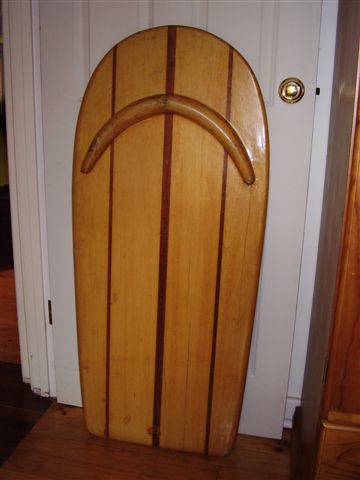 |
|
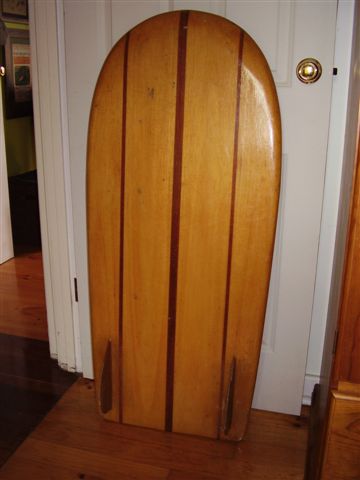 |
Photos by: Mike Brown. |
4. When was that?
They brought in a flexible type of chestboard. It was like a type of foam one. I can't remember when they came in.
Bill Clymer bellyboard fins. Photo Mike Brown.
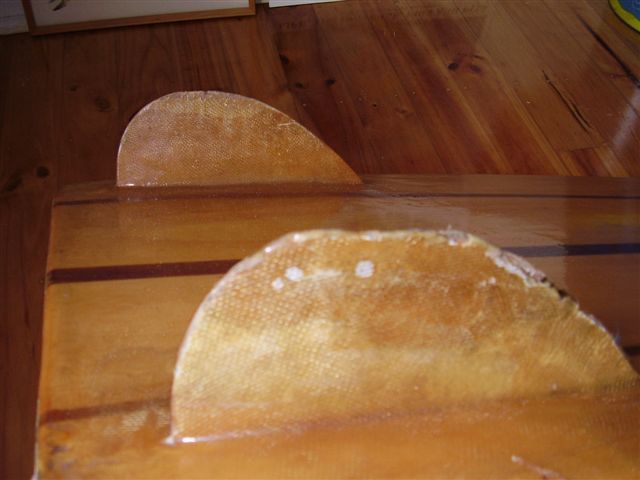
If that was the boogie board that was about the mid-1970s.
Yeah.
5. Where did you mostly surf?
Either off at the Bower, at Dee Why, Long Reef, out at Bungan -- places like that where there was a decent sort of shore run.
What sort of waves did your boards go best in?
Probably steeper
ones. They weren't much good at getting onto a full wave because you
didn't have the speed at the drop. You had to sort of had to pick them
up when they were lifting up fairly steep. You went for the steeper
waves, when there was a good one break, building up fairly steep so you
could onto them straight away and get your speed.
Would they ride the tube?
They were good in that.
6. Do you recall the types of flippers you used?
They were a shorter flipper. I think they were a Churchill, the type of flippers we had.
I'd heard Dick Turnbull, from Bondi, made flippers.
There was a bloke
called Turnbull who made them over there. I used Churchills. Only
because that's what I happened to have. The blokes grabbed whatever
they could from the surf club. They'd wear whatever they could get hold
of.
7. The boards you shaped, did they differ much from the Clymer boards, except being longer and having bigger fins?
No, it was pretty well the same shape. Just a bit longer.
That was only a few I did because I preferred a longer board. The
shorter ones you had more of your body trailing in the water behind it.
So there would be more drag?
I thought so.
Were the boards you made still out of balsa?
Yes.
What was the purpose of the handle?
You had to have
something to grab hold of. It was no good grabbing hold of the side of
it because it would restrict your speed, it would have you cut into the
water. The idea was this round part at the front, that you would call a
splash or something like that, that you would hang onto.
Did you use the handle to get leverage in turns?
You would get
leverage out of it, so you could manoeuver, to cut into the face of the
wave. You would hang onto that so you lead your board into the face of
the wave and travel across the face of it. You couldn't hang onto the
side of the board because it interfered with your speed and that sort
of thing. You are traveling across the face of the wave and you have
your hand over the side, you are going to interfere with it. You would
hang onto the handle and sort of lean into it, lean the edge of the
board into it and sometimes with just one fin, traveling across the
face of the wave. Nearly horizontally.
8. So you could do pretty radical turns?
Yeah.
9. In your travels did you see chestboards anywhere else?
Western Australia had a funny sort of one. It was a molded ply one.
This was in the mid-1950s. I was over there for the Australian
championships, at Scarborough. A very popular sort of chestboard they
had, it was about ½" thick and it was molded ply with a curved up
front, and with two sort of handles at the front, that you hung onto;
set back from the front that you hung onto. It had the same effect as
the ones back in Sydney
They weren't made by Don Vidler?
I don't know who made them.
So they were a very different style of board?
They still had two
small fins at the back but they were made of molded ply. They were
only about ½" thick so they could mold up the ply to get the turn up
at the front.
So they were surfed around Scarborough?
Yeah.
10. In Sydney, did you run into many chestboard riders?
Not really. We weren't sort of like surfies like you have
now that travel up and down the coast, that sort of thing. In those
days it was just blokes in surf clubs who surfed, with their boards and
that. Now you get groups that aren't in surf clubs that surf. You get
board clubs that travel up and down the coast with their boards.
11. What can you tell me about Gus and Goose?
Very little. Billy McMahon told me that Goose could stand up and Gus
(Garland) would lay on his chest. They were members of the surf club
only for a short time. I haven't seen them for years.
Were their boards similar to yours?
I think so
12. Do you recall the 1956 Olympic team coming to Manly at all?
No, not really.
I believe they had a couple of chestboards they brought with them.
They could have. That
was when they had the Melbourne Olympics. At that time I wasn't into
chestboards because I was rowing with a different club. It was only
when I joined Manly that we got interested in chestboards.
What year was that?
That would have been 1958 or 1959.
13. When were you working for Bill Clymer?
About that time. He had a factory out at Brookvale. At
that time he started making surfboat oars. He was doing balsa boards as
well.
How did he get into the chestboards?
It was the offcuts.
When he bought the balsa, they were eight feet or longer, there was a
bit of waste, the offcuts from them. No they might have been longer, 10
feet, because at that time a lot of balsa boards were about eight foot
long. The offcuts and that sort of thing were joined and made these
chestboards. Waste left over.
So they weren't single pieces of wood.
No, they were all
joined together. The same as the surfboards then. The planks for the
surfboards were only about eight inches wide and three inches thick.
They were all glued together and shaped from that.
Clymer bellyboard - with offcut construction clearly visible. Photo Torquay SurfWorld.
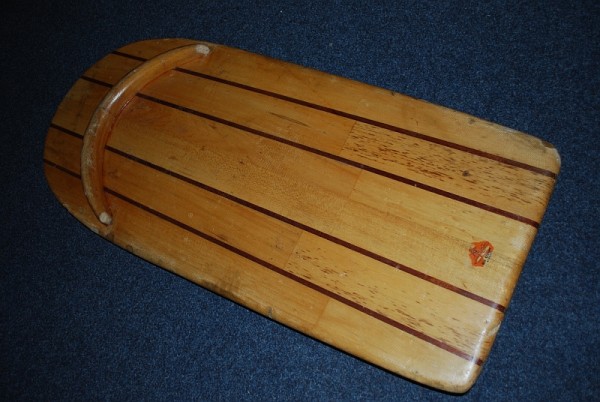
14. How many chestboards were made?
Forty I suppose, it wouldn't have been any more than that.
Clymer logo. Photo Mike Brown.
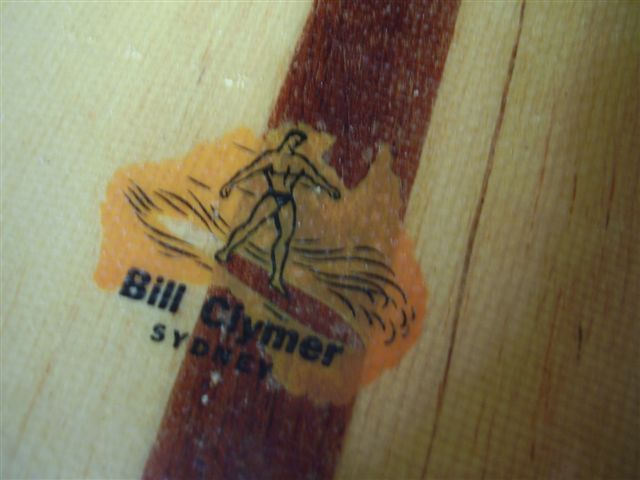
Any idea where the main market was?
Local guys. Gordon
Woods was then making boards then. He was his competition then. Whether
he made chestboards I don't know.
It was just a thing on the side that had taken off. There were a few
groups that were doing it. It took over from surfoplanes. Those blown
up rubber things that the guys used. It took up from there. There
wasn't a big following. It was just a few blokes up and down the coast
around Sydney who were keen to go out when there was a big surf. They
would all get out there and surf them.
15. Who worked at Clymers? What was your job?
Joey Larkin was doing his glassing and that sort of thing
at that time. He is up at Kirra, he's been up there quite a while. He's
quite an identity up there. He still makes surf boards but he makes
them out of balsa, or out of timber, balsa, with all these fancy
designs on them. He does specialist type of boards
Anyone else?
Just Bill and he. Bill worked on his own.
What was your job at Clymers?
I was just helping
him out. He swept the boat crew that I was in. I had stuffed my wrist
up and had plaster from my bloody arm up to my elbow. At that time I
was working as a carpenter and I couldn't use the straight tools. The
only thing I could use was an electric planer which I could hold in two
hands, so I shaped chestboards for him.
So how long were you making the chest boards?
Not long, probably only a couple of months.
Did he keep making them after you left?
No, not a great
deal. As I said it was just to use offcuts off his boards. We'd just
join them up, glue them up and shape the chestboards. It was a market
for the scrap that he had.
So did you make most of the Clymer chestboards?
No, Bill made a few himself.
16. For you, what was the attraction of riding a chestboard?
It was just a thing of the time. I suppose just the
excitement of getting out in a big surf, a steep break and just flying
across the face of it. It is the same as these days a bloke on a board
getting a wave, coming down and flying through the tube or flying
through the face of it and getting a long run.
So it was the steep long waves you enjoyed?
Yeah.
17. Are there any waves that you can remember or still stand out that you rode on a chestboard?
Not really.
Where was your favourite spot?
The Bower was good, the southern corner of Dee Why. Bungan beach, it used to be very good.
Fairy Bower
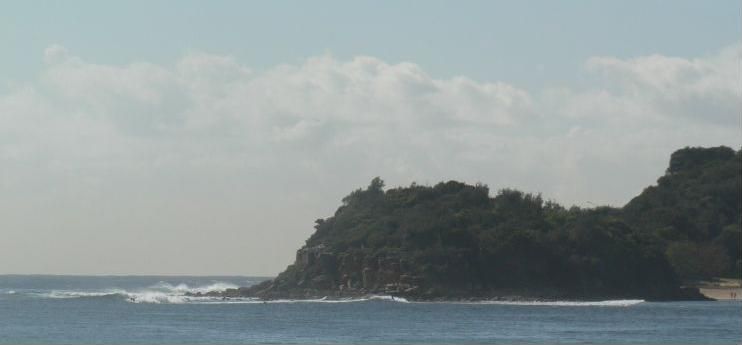
Is Dee Why what they call Dee Why Point? Were there many other surfers who surfed there?
Yeah. As I said
before it was just a group of us in the Manly club. When the waves were
on somewhere, just like these days, when there is a wave on somewhere
all the boardriders get there as quick as they can. We didn't have the
completion. It was not near as popular as these days with boardriders
there. They appear out of the woodwork when there is a surf on.
Letter to Surfing World magazine, January 1964. The author was Dick Browning and the other surfers were: Bob Padman, Roger
Griffiths, Tony Dawes, Barry Taylor, Nev Taylor, Bains is unknown and Rob Lovell.

Source: Letter to the Editor. (1964, January). Surfing World, 3(5). Copy is courtesy of Henry Marfleet.
So you were surfing DeeWhy, largely you and your friends?
That's right. At
times there would be just our friends and we would be the only surfers
there so we had it to ourselves. It was a completely different sort of
thing. The problem in those days was when the boards got more popular,
like now, they'd drop in on you because they could get a wave before
you could. They could get more speed up with the length of their board.
On a chestboard you had to drop straight into a steep wave and you'd
have a boardrider he would be flying along and cut you off. There was a
bit of competition there.
So once boards became more popular it was a lot harder catching waves?
It got more crowded
and you got hassled out a bit. I notice now and I live opposite the
Bower there are still kids coming over from the city and they have
their chestboards, they are made of a flexible foam. You often see them
at the Bower when there is a decent wave there. Cutting across Winkipop
and a right hand turn across the face of the Bower.
18. Any final comments.
It was just a thing of the time. Something we did when there was a wave on and that was it.
|
|







